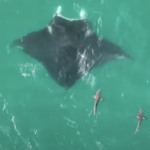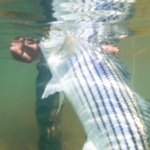
Veteran Florida Guides Concerned About False Albacore
While the ASGA team is extremely proud of the community we’re building with the Guide
What a week for striped bass! By now, I imagine many of you know that the Atlantic States Marine Fisheries Commission’s Striped Bass Board took historic action to conserve striped bass and there will be new regs over the next few months. We’d like to extend a huge THANK YOU to the entire striped bass community for their support and several key Board members for their foresight and leadership—Striped bass are without a doubt in a better position for future abundance today than they were last week. This community played a real role towards that.
Normally, ASGA’s meeting recap blogs are one document, but considering the historic nature of the striped bass decisions, we decided to do two parts. This blog will cover striped bass, and Part Two, will cover the false albacore-Atlantic Bonito discussion and some additional discussions.
The Striped Bass Board was the meeting’s most pivotal and anticipated, due to significant recreational harvests increase in 2022 destroying rebuilding projections. If you’re interested to learn more about that development and lead-up to this meeting, check out this blog. ASGA’s primary ask was to initiate Addendum II to change regulations in 2024 to protect the 2015-year class. Those 2015s represent the eighth best year class in the time-series and our last best hope to rebuild the stock by 2029. However, we remained incredibly concerned about what harvest on the 2015s would look like in 2023, because 100% of the 2015s would be recruited into the slot limit for this year—harvests assumedly would increase over the doubled-harvest in 2022.
In our early conversations with Board Members, we began to hear murmurs of the possibility to do something immediately to impact the 2023 season: a little known and rarely used management tool in the ASMFC’s Charter, Emergency Action. Obviously, we were intrigued by the possibility to do something now to prevent a rebuilding failure, but we had our doubts the Board would Act, let alone meet the 2/3rd vote threshold. Sure enough, however, the Board acted decisively on both the Addendum and Emergency Action, and ASGA cannot thank them enough.
I’ll be diving deeper into each of the three actions the Board approved, but here is a quick hit (in order they were approved):
After the Technical Committee received a presentation on updated (and all but failed) rebuilding projections, Dr. Justin Davis of Connecticut offered the first motion to initiate Addendum II. It was seconded by Emerson Hasbrouck of New York. In his rationale, Dr. Davis leaned on the progress the Board has made in recent years to be more conservative with this fish, the clear guidance that striped bass will not rebuild without action, the need to place conservation on ALL sectors, and the opportunity to reassess after the 2024 assessment update. We couldn’t agree more on any of those points.
After some supporting discussion, Dr. Mike Armstrong of Massachusetts offered a motion to add a provision: to grant the Board authority to make changes after upcoming stock assessments if rebuilding projections fall below 50%. Despite some fringe comments questioning the validity of the 2023 data/projections and the reality of reaching the SSB Target—this is similar to a provision made during the Amendment 7 process a couple years back. The amended motion passed unanimously.

ASGA fully supports this motion and the tools it grants the Board. We need to rebuild striped bass, and this motion will certainly make that more realistic. And, again, unanimous support for precautionary management and conservation at the SB Board, maybe the Board is evolving for the better? Kudos to Justin Davis, Emerson Hasbrouck, Mike Armstrong, David Borden, and the rest of the SB Board for carrying this action. The Board, however, was far from finished.
Immediately after Addendum II was successfully initiated, Dr. Mike Armstrong, who will go down in the history of striped bass as one of the most influential voices for conservation and responsible management, dropped the Emergency Action Bomb. The following motion was seconded by David Borden, another indelible voice for a healthy striped bass resource.

After this motion hit the table, things got much more interesting. ASGA was aware that some sort of Emergency Action would be discussed at the meeting, but, again, we weren’t sure whether there would be 11 votes to overcome the 2/3rd threshold. Armstrong opened the discussion up with his rationale, which focused on the fact that more of the 2015-year class would be available to harvest in 2023 than in 2022. “There is no question in my mind that 2023 harvest will be the same or greater than 2022,” said Armstrong (disclaimer this quote is from my meeting notes and may not be transcribed 100% but the point holds true). Armstrong also mentioned that this board needs to do everything it can to ensure successful rebuilding, and that means protecting what is in the stock now, because there is nothing coming into the stock with the poor recruitment. Borden added that he is concerned about far more draconian measures down the road unless the Board acts today—something ASGA mentioned many times publicly and in conversations with Board members. An ounce of prevention is worth a pound a cure, a core tenet of precautionary management.
Around the table, we started hearing encouraging signs of support and wondered “this thing might actually have legs.” Even Maryland voiced support—” I originally thought this was crazy, but certainly understand the need and desire for this. If we wait another year, we are looking down the barrel at something much, much worse,” said MD’s Administrative Proxy, Mike Luisi.
Two subsequent motions came up. First, a motion to exclude the for-hire fleet from the EA was brought forward by CT’s Justin Davis to provide some relief to the charter/for-hire fleet that presumably markets trips to bring fish home. That was voted down, which ASGA supported. While we are part of the charter/for hire fleet, we firmly believe that all sectors should be treated equally, including commercials, which Addendum II will address.
Then NJ took the spotlight. NJ Board members began questioning the validity and need to take immediate action. This culminated with NJ’s Legislative Proxy, Adam Nowalsky, offering a motion to postpone this action until the summer meeting. Nothing says emergency action like one state trying to postpone that emergency action. One of the reasons for the motion was lack of public comment or even awareness that this was on the table, which is admittedly a fair one. However, Representative Sarah Peak, MA’s Legislative Proxy, had the perfect rebuttal: based on her reading of public comment over the past few actions, the public supports strong, swift action, and in her opinion “the public would applaud this.” Thank you, Rep. Peak—we do support this unprecedented action, and a strong segment of the public is applauding. The motion to postpone failed 2 (NJ and DE) to 14.
Once the Board got back to the main motion, the vote was taken. There were 15 votes in favor to one opposed (NJ). We couldn’t believe it. The Board had just taken one of the single strongest and bravest steps for conservation in decades in order to successfully rebuild the striped bass stock.
Now, we understand that striped bass fishing is really darn good now (NJ northward, for the most part). Had the EA and AddII not been initiated, however, we most certainly would have been staring down the barrel of a gun, quite possibly one loaded with a moratorium. Recruitment in the Chesapeake Bay continues to be a huge problem, and this year’s conditions are not conducive to a good spawn (which have materialized out of poor environmental conditions, but that’s unlikely), and the 2015s would have been ravaged with a full fishing year completely in the slot. The Board needed to act decisively to stem the bleeding and give this fishery the best chance to rebuild, and it did that.
With all the challenges in fisheries management—climate change, variable and uncontrollable spawning success, fishing effort, fishing efficiency, angler behavior, data precision—we have to lean on precautionary management if we want abundant, healthy fisheries for the long-term. On May 2nd, 2023, the Striped Bass Management Board did just that. Truly, what an incredible day for this resource and the thousands of stakeholders looking to the Board to do the right thing.

Back at the Winter ASMFC Meeting this past January, the SB Board decided to postpone their decision on Addendum I—Commercial Ocean Quota Transfers—to get more information about the impact transfers and maximizing commercial quota utilization could have on the stock. Regardless of the small proportion commercial harvest has on total removals (usually 10-15%), maximizing quota utilization was shown to have an impact. Additionally, considering the drastically decreased rebuilding projections and the serious actions the Board just took to get rebuilding back on track, we felt pretty confident the board would make a good decision. Ultimately, they approved Option E, which only allows commercial ocean quota transfers with Board approval and only when the stock is NOT overfished. So, transfers would only be permitted once the striped bass stock rebuild (2029 or in six years best case scenario) and then a transfer request will need a majority vote at the Board. ASGA is ok with this outcome, especially considering the promising commercial reform which may come out of Addendum II.
We cannot reiterate it enough: this was a historic meeting for the long-term health and abundance of striped bass. The Board showed the public that it hears their concerns and is acting decisively and conservatively to recover the stock. Further, the Board is intent on taking a look at the entire fishery—ocean rec, Chesapeake Bay rec, and all commercial fisheries—in Addendum II to tackle rebuilding. This is a shared resource, thus the responsibility to rebuild should be shared. The Emergency Action will stem the harvest pressure on the prolific 2015s this year, hopefully, keeping more fish in the water for the future. All in all, this meeting could not have gone better or been possible without the public’s strong voice for conservation. Thanks again to all involved, and let’s do all we can to rebuild striped bass!
Stay tuned for Part II!
cover picture: Hardlined, KGB Productions

While the ASGA team is extremely proud of the community we’re building with the Guide

Feature Image: A false albacore being landed off Jupiter Florida by the Cheeky Fishing team,

Feature Photo: “Best Practices for Fishing Cobia Around Manta Rays” The Florida Manta Project is

We caught this article a few days ago. Here’s the summary: Maryland striped bass commercial
We rely on our members and donations to keep fighting for a sustainable tomorrow in marine conservation.
By using this website, you agree to our use of cookies. We use cookies to provide you with a great experience and to help our website run effectively. To learn more, please review our privacy policy.
9 Responses
What are the new regulations for commercial harvests in NYS? The old rule of up to 38 inches was ridiculous. Will sb tags still be issued? Same numbers and regulations?
I totally agree with the 28”-31” slot for recreational fishermen to protect the breeders. But what about the commercial fishermen still allowed to take unlimited fish over 34”, the breeders. Until some restrictions are put on the commercial fishermen the striped bass population will not respond to the new restrictions put on the recreational fishermen. The striped bass should be classified as a game fish with no commercial fishing allowed. This giant step will definitely sustain the resurgence of the population.
Thank all of you–everyone involved– for your hard work.
Can we also thank the ASMFC? I think that’s something we should do.
Thank you to everyone involved with the conservation of “our” fisherie. I have taken personal steps to do my part in trying my best to make sure that the fish I catch are released healthy. No weighing fish. Changed all plugs to one single belly treble with counter weight on rear. Unhooking and releasing fish as quickly as possible with shortest amount of time out of water as possible. I invited two people to attend the event in Marshfield at the brewery. I’ve been attaching all information and events to my social media. I want to recognize and thank the Plum island surfcasters, surfland bait and tackle, the saltwater edge, Jerry Audet, Dave Anderson for all their help, education and engagement to the conservation of striped bass. I will continue to due my part and be as active as I can to ensure that future generations have access to a healthy fisherie.
I understand commercial fishermen have families to support, but slaughtering everything in the ocean does not help anything. There has to be more accountability for overfishing and bycatch. BTW, if we continue to let the Menhaden harvest (purely commercial) go on like it is, we’re not going to have to worry about stripers, bluefish or any other gamefish because they will disappear. Having said that, let’s turn to recreational fishing. My guess is there are very few people whose existence relies on eating striped bass. Maybe we should consider a ZERO recreational harvest for a few years. I’m sure there will be those that respond as though some birthright is being stripped from them, but that is short sighted. Isn’t simply landing these incredible animals and returning them in good shape back to the ocean enough? I like to eat fresh fish too, but I would stop if I knew it would keep them around for a long time.
Thanks for all of the comments! This is a wholesale response to all the questions about commercial accountability. All sectors have to do their part in rebuilding. If you scroll up on this blog and find “Move to initiate Addendum”, you will see the commercial portion of accountability. The first portion states that comm and rec fisheries must get below the F target. That roughly translates into how many fish are dying from fishing (mortality). The second thing that should stick it is “maximum size” for commercial fisheries. While the initial action (Emergency Action) was rec only, the addendum will address all sectors. Expect more on that in the upcoming weeks.